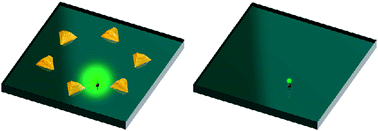Plasmonic fluorescence enhancement by metal nanostructures: shaping the future of bionanotechnology
Abstract
This review focuses on metal enhanced fluorescence (MEF) and its current and future applications in biotechnology. The mechanisms of MEF are discussed in terms of the additional radiative and nonradiative decay rates caused by the close proximity of the metal. We then review the current MEF materials and structures that show promise in bioapplications. The use of electromagnetic modelling to predict fluorescent rate enhancement is then considered. We then give particular focus to the recent work carried out in the homogeneous fabrication of metal

- This article is part of the themed collection: Recent Developments in Metal-Enhanced Fluorescence

 Please wait while we load your content...
Please wait while we load your content...